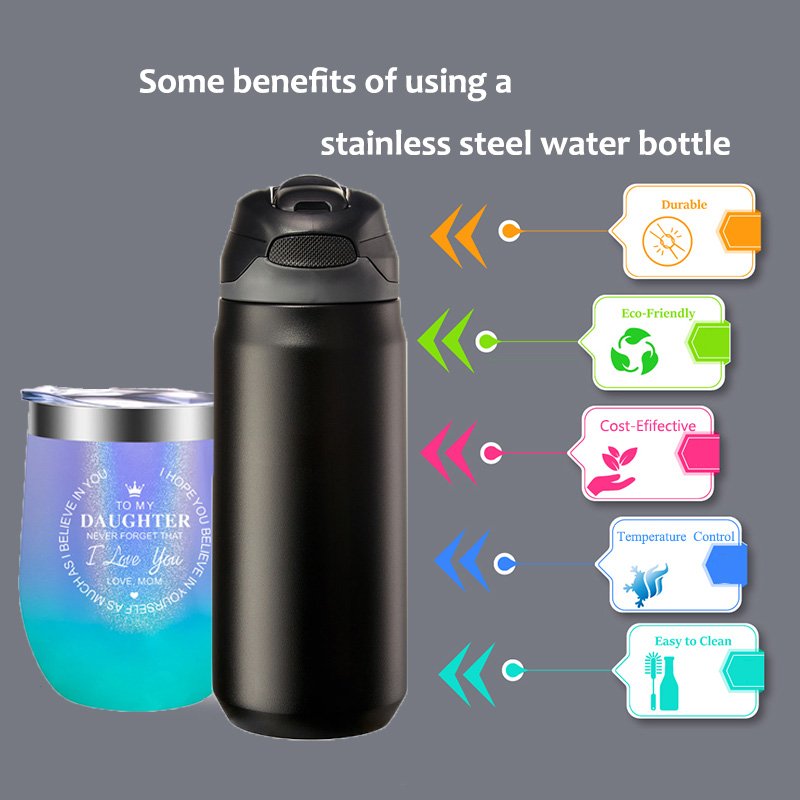The Importance of Washing Your Water Bottle
Regularly washing your water bottle is crucial for maintaining both your health and the quality of the beverages you consume. One of the primary reasons for this is the potential growth of harmful bacteria, mold, and mildew. When a water bottle is not cleaned consistently, it becomes a breeding ground for these microorganisms, which can pose significant health risks. Bacteria such as E. coli, Salmonella, and Staphylococcus can thrive in the moist environment of an unwashed water bottle, leading to infections and illnesses.
Additionally, mold and mildew can develop inside the bottle, particularly if it is stored in a damp or dark place. These fungi not only compromise the cleanliness of your water bottle but can also emit unpleasant odors and affect the taste of your drinks. Consuming beverages from a moldy water bottle can lead to respiratory problems and allergic reactions, further underscoring the need for regular cleaning.
Residue from previous drinks is another concern that necessitates frequent washing of your water bottle. Leftover particles from beverages such as juice, sports drinks, or even flavored water can accumulate over time, altering the taste and quality of the water you subsequently fill the bottle with. This residue can also contribute to the growth of bacteria and mold, amplifying the health risks associated with an unclean bottle.
Research studies have highlighted the dangers of using unclean water bottles. For instance, a study conducted by TreadmillReviews.net found that the average reusable water bottle contains more bacteria than a dog’s toy. Such findings emphasize the importance of maintaining hygiene and regularly washing your water bottle to prevent the ingestion of harmful microorganisms.
Ultimately, the importance of washing your water bottle cannot be overstated. By committing to a routine cleaning schedule, you can ensure that your water bottle remains safe, hygienic, and free from contaminants, thereby safeguarding your health and enhancing the quality of your hydration experience.
Recommended Cleaning Frequency
The cleaning frequency of water bottles can vary significantly based on several factors, such as the material of the bottle, the types of beverages stored, and how frequently the bottle is used. Expert recommendations generally suggest washing your water bottle after each use or at least once a day to maintain optimal hygiene.
For plastic water bottles, it is particularly important to clean them regularly. Plastic can retain odors and flavors more easily than other materials, and it is prone to scratches that can harbor bacteria. Therefore, it is advisable to wash plastic bottles daily, especially if they are used for beverages other than water, such as sports drinks or juices.
Stainless steel water bottles are more resistant to retaining flavors and odors. However, they should still be cleaned regularly. A daily wash is recommended, but if you use the bottle solely for water and refill it multiple times a day, it might be acceptable to wash it every other day. If the bottle is used for other beverages, a daily wash becomes imperative.
Glass water bottles are generally easier to clean and do not retain flavors or odors as much as plastic or stainless steel. Nonetheless, they should also be washed daily, especially if used for beverages other than water. The smooth surface of glass makes it less likely to harbor bacteria, but routine cleaning ensures all residues are removed.
The type of beverage stored in your water bottle significantly affects the cleaning frequency. Water is less likely to leave residues, but flavored drinks, sports drinks, and juices can leave sugars and other substances that promote bacterial growth. Therefore, bottles used for these types of beverages must be washed thoroughly after each use.
Finally, the frequency of use plays a crucial role. If you use your water bottle multiple times throughout the day, washing it daily is necessary to prevent bacteria buildup. Conversely, if the bottle is used less frequently, it should still be cleaned regularly to ensure it remains hygienic.
In summary, regardless of the material, it’s best to wash your water bottle after each use or at least once a day. This practice ensures that your bottle remains clean and free from harmful bacteria, promoting better health and hygiene.
Effective Cleaning Methods and Products
Proper maintenance of your water bottle is crucial for both health and longevity. Various cleaning methods and products can ensure your bottle remains hygienic and in optimal condition. One of the most straightforward techniques is hand washing. Begin by disassembling the bottle, removing any caps, straws, or accessories. Use warm water and a mild dish soap to clean each component thoroughly. A sponge or soft cloth can be employed to scrub the interior and exterior surfaces, ensuring all areas are adequately covered.
For those hard-to-reach spots, particularly inside the bottle, bottle brushes are invaluable. These brushes often come with long handles and flexible bristles, making it easier to clean narrow openings and corners effectively. Submerge the brush in soapy water and scrub the inside of the bottle, paying special attention to the bottom and any crevices where dirt may accumulate.
If your water bottle is marked as dishwasher-safe, this can be a convenient and efficient cleaning method. Place the bottle and its components securely in the dishwasher, ensuring they are positioned to allow water flow through all parts. Use a standard dishwasher detergent, avoiding any with harsh chemicals that might degrade the bottle’s material over time.
In addition to these traditional methods, several specialized cleaning agents can be employed for a more thorough cleanse. Baking soda and vinegar are common household items that are both safe and effective. For a deep clean, fill the bottle with a mixture of warm water, one teaspoon of baking soda, and one teaspoon of vinegar. Let it sit for a few hours or overnight, then rinse thoroughly with warm water. Alternatively, specialized bottle cleaning tablets are available; simply follow the manufacturer’s instructions for use.
Maintaining your water bottle’s condition also involves avoiding harsh chemicals and abrasive materials that could damage the surface. Regularly inspect seals and gaskets to ensure they remain intact and free from mold. By following these guidelines, you can ensure your water bottle remains clean, safe, and durable for regular use.
Maintaining Your Water Bottle Between Washes
Ensuring the cleanliness of your water bottle between washes is crucial for maintaining both hygiene and the longevity of the bottle. One of the simplest and most effective strategies is to rinse your water bottle with hot water after each use. This helps remove any residual liquid and prevents the buildup of bacteria. Additionally, allowing the bottle to air dry completely before the next use is vital. Moisture can harbor bacteria, so always store your bottle with the cap off to promote thorough drying and prevent moisture buildup.
Avoiding contamination is another key aspect of maintaining your water bottle. Sharing your water bottle with others can introduce new germs and bacteria, which can multiply in the moist environment of the bottle. Therefore, it is advisable to use your water bottle exclusively. Furthermore, be cautious about where you place your bottle. Surfaces in public places can be teeming with germs, so always keep your bottle away from potentially contaminated surfaces.
Regular inspections of your water bottle can also help maintain its cleanliness. Check for any signs of mold or residue inside the bottle, as these can indicate that it needs a more thorough cleaning or even replacement. Pay attention to the condition of the bottle’s components, such as the cap and any seals, and replace them if they show signs of wear or damage. This will ensure that your water bottle remains a safe and reliable source of hydration.
By following these practical strategies, you can keep your water bottle as clean as possible between washes, ensuring your hydration routine remains both safe and effective.




pharmacy canadian superstore
https://expresscanadapharm.com/# canada rx pharmacy
my canadian pharmacy
Always ahead of the curve with global healthcare trends.
where can i buy cipro without prescription
Delivering worldwide standards with every prescription.
They keep a broad spectrum of rare medications.
cytotec for sale meetup
A pharmacy that sets the gold standard.
Their health awareness programs are game-changers.
gabapentin for chronic daily headache
They’re reshaping international pharmaceutical care.
Their global outlook is evident in their expansive services.
can i order cheap cipro pills
Always on the pulse of international healthcare developments.
гарантия при продаже аккаунтов гарантия при продаже аккаунтов
гарантия при продаже аккаунтов платформа для покупки аккаунтов
купить аккаунт с прокачкой купить аккаунт
маркетплейс аккаунтов https://ploshadka-prodazha-akkauntov.ru
маркетплейс для реселлеров маркетплейс аккаунтов соцсетей
магазин аккаунтов социальных сетей магазин аккаунтов
биржа аккаунтов https://pokupka-akkauntov-online.ru/
Account Selling Platform Secure Account Sales
Website for Selling Accounts Ready-Made Accounts for Sale
Account trading platform Account Acquisition
Database of Accounts for Sale https://buyaccountsmarketplace.com/
Account Buying Platform Sell Pre-made Account
Account Buying Service Find Accounts for Sale
Account Selling Service Account market
Website for Selling Accounts Account Trading Platform
Gaming account marketplace Secure Account Sales
Account Buying Service Account Selling Service
account acquisition account marketplace
account selling service account buying platform
website for buying accounts https://socialaccountssale.com/
account exchange service ready-made accounts for sale
marketplace for ready-made accounts purchase ready-made accounts
account market buy pre-made account
account store database of accounts for sale
account trading platform accounts marketplace
profitable account sales accounts for sale
secure account sales accounts for sale
online account store account trading
account sale account exchange service
buy accounts account selling service
social media account marketplace marketplace for ready-made accounts
account buying platform account exchange service
account selling service account exchange service
buy account sell pre-made account
account exchange service account sale
accounts for sale buy-social-accounts.org
account buying platform secure account sales
secure account sales account trading
ready-made accounts for sale https://accounts-market-soc.org/
accounts for sale buy accounts
secure account sales marketplace for ready-made accounts
ready-made accounts for sale account marketplace
account trading secure account purchasing platform
verified accounts for sale account store
online account store buy accounts
gaming account marketplace https://accounts-marketplace.xyz/
website for selling accounts social-accounts-marketplaces.live
account sale https://accounts-marketplace.live/
account acquisition https://social-accounts-marketplace.xyz
accounts for sale https://buy-accounts.space/
sell accounts https://buy-accounts-shop.pro
profitable account sales https://buy-accounts.live
website for selling accounts accounts marketplace
account trading https://social-accounts-marketplace.live
account exchange service accounts-marketplace-best.pro
купить аккаунт купить аккаунт
магазин аккаунтов https://rynok-akkauntov.top/
маркетплейс аккаунтов https://kupit-akkaunt.xyz/
биржа аккаунтов akkaunt-magazin.online
маркетплейс аккаунтов соцсетей https://akkaunty-market.live/
маркетплейс аккаунтов соцсетей https://kupit-akkaunty-market.xyz/
купить аккаунт https://akkaunty-optom.live
продать аккаунт https://online-akkaunty-magazin.xyz/
маркетплейс аккаунтов соцсетей https://akkaunty-dlya-prodazhi.pro
купить аккаунт https://kupit-akkaunt.online
buy facebook advertising https://buy-adsaccounts.work
buy facebook accounts for advertising buy facebook ad account
buying facebook ad account https://buy-ad-account.top
buy fb ad account https://buy-ads-account.click
facebook ad account buy fb account for sale
buy facebook ads manager facebook ads account for sale
buy accounts facebook buy fb ad account
В этой статье-обзоре мы соберем актуальную информацию и интересные факты, которые освещают важные темы. Читатели смогут ознакомиться с различными мнениями и подходами, что позволит им расширить кругозор и глубже понять обсуждаемые вопросы.
Получить больше информации – https://medalkoblog.ru/
buying facebook ad account https://buy-ad-account.click
buy facebook ads accounts https://ad-accounts-for-sale.work
adwords account for sale buy verified google ads accounts
buy aged google ads account google ads account buy
buying facebook ad account https://buy-accounts.click/
buy google agency account https://ads-account-for-sale.top
buy old google ads account buy google agency account
buy google ads accounts buy-ads-invoice-account.top
buy google ad threshold account https://buy-account-ads.work
buy aged google ads account buy google ads accounts
buy google ads threshold accounts buy verified google ads accounts
buy google adwords accounts buy google ads accounts
verified business manager for sale https://buy-business-manager.org
buy google ads threshold account google ads agency account buy
facebook business manager buy buy-bm-account.org
fb bussiness manager buy-verified-business-manager-account.org
buy verified facebook business manager account https://buy-verified-business-manager.org
buy facebook verified business account https://buy-business-manager-acc.org
buy facebook bm https://business-manager-for-sale.org/
buy facebook business manager accounts buy-business-manager-verified.org
verified bm https://buy-bm.org
unlimited bm facebook https://buy-business-manager-accounts.org/
tiktok ads agency account https://buy-tiktok-ads-account.org
buy fb bm https://verified-business-manager-for-sale.org/
buy tiktok ads https://tiktok-ads-account-buy.org
buy tiktok business account https://tiktok-ads-account-for-sale.org
buy tiktok ads https://tiktok-agency-account-for-sale.org
buy tiktok ads https://buy-tiktok-ad-account.org
tiktok ad accounts https://buy-tiktok-ads-accounts.org
tiktok agency account for sale https://tiktok-ads-agency-account.org
tiktok ads account buy https://buy-tiktok-business-account.org
tiktok ads account for sale https://buy-tiktok-ads.org
buy facebook accounts for ads purchase ready-made accounts social media account marketplace
buying facebook account sell account account marketplace
Wir können mit Zuversicht sagen, dass Sie buchstäblich alles finden können, wonach
Sie suchen. Deshalb bieten wir Ihnen echte, ehrliche Empfehlungen für beides.
Darüber hinaus wissen wir, wie schwer es ist, anständige Casino-Seiten oder Boni zu finden, denen Sie Ihre Zeit und Ihr Geld anvertrauen können. VegasSlotsOnline ist
eine Website, die 2013 von einer Gruppe langjähriger Glücksspiel-
und Slot-Enthusiasten gegründet wurde. Spielen Sie
für Echtgeld, um bei unseren empfohlenen Vegas Online Casinos für 2025 im großen Stil zu gewinnen. VegasSlotsOnline
hält Sie selbstverständlich auf dem Laufenden, was die Aktionen von Casinos
und Spielanbietern anbietet.
Hergestellt werden die Spielautomaten von Softwarefirmen. Allerdings sind Bonus-Buy-Funktionen in deutschen Echtgeld-Spielotheken nicht erlaubt.
Du musst das Spiel einfach öffnen und kannst zwischen Spielgeld-
und Echtgeld-Modus wählen. Wer einen Mittelweg sucht, kann auf
Slots mit mittlerer Volatilität setzen, die allerdings etwas seltener zu finden sind.
Die Volatilität eines Slots bestimmt, wie oft und wie hoch Gewinne
ausfallen. Einige virtuelle Spielautomaten bieten sogar Werte von über 97%, während ältere häufig
etwas darunter liegen.
Im Zuge des Glücksspielstaatsvertrags 2021 ist mit einigen Einschränkungen zu rechnen, wie etwa eine 5 Sekunden Pause zwischen den Spielrunden. Die Echtgeld
Slots sind die mit Abstand beliebteste Kategorie von Online Casino Spielen in Deutschland.
Mit der Gemeinsamen Glücksspielbehörde der Länder (GGL) gibt es erstmals eine
zentrale Aufsicht für Online Glücksspiel in Deutschland.
References:
https://online-spielhallen.de/ihr-ultimativer-leitfaden-zu-bigg-casino-cashback/